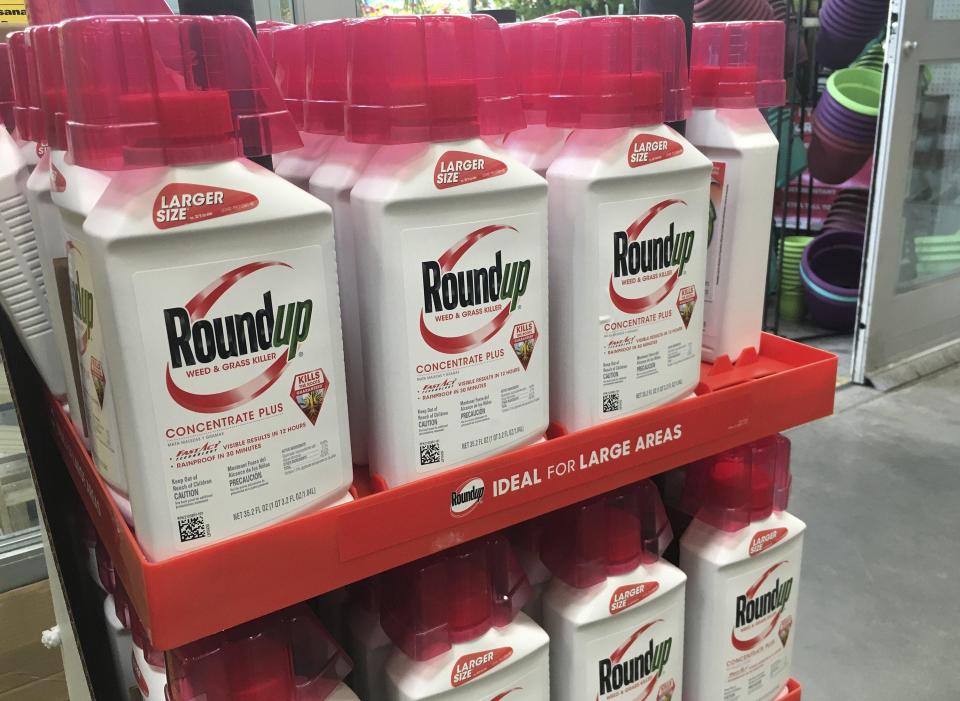Traces of weedkiller found in urine of 7 in 10 pregnant women in Indiana, new study says
Pregnant women in Indiana have increasing amounts of potentially harmful weedkillers in their bodies, according to a new study published last month
The study led by Indiana University School of Medicine found 7 of 10 pregnant women tested between 2020 and 2022 had traces of an herbicide called dicamba in their urine.
That number is up from 2.5 in a similar analysis a decade ago.
Not only did more women have dicamba in their systems, concentrations of the weedkiller in their urine had risen by more than four times.
The study of more than 150 women — including many from Indianapolis and surrounding suburban areas — revealed every woman also had traces of 2,4-D, another potentially dangerous weedkiller, in their urine. That was the same finding from 10 years ago, but there was no significant increase in the concentration levels for that weedkiller.
“If it’s in mom’s urine, then it’s in mom’s blood,” Dr. David Haas, a professor of obstetrics and gynecology at IU School of Medicine as well as an author on the study, told IndyStar. “And if it’s in mom’s blood, then it’s at least gotten to the placenta."
The study does not make any connections to or claims about potential health effects. It only looked for the presence of these chemicals, which Haas described as the first step.
Researchers will now focus on what the study’s findings “mean for reproductive health and for the health outcomes of mom and children,” the doctor said.
“This is really important,” Haas said. “What happens in the uterus can help define the course of the child’s trajectory.”
Herbicide application soars, unknown risks
The new findings come as the application of pesticides to crops on farm fields has exploded since the 1980s. The use of glyphosate, the key ingredient in well-known Roundup, soared in the 1990s and early 2000s, which triggered weeds resistant to the chemical. That sparked the need to find alternative weedkillers.
Monsanto and other agrochemical companies then developed crops resistant to dicamba and 2,4-D, which increased reliance on the two weedkillers as another option. As a result, the use of those two chemicals has grown 10-fold, since 2010, according to data from a U.S. Department of Agriculture statistic service.

In Indiana, that is particularly true for soybeans, one of the state's top crops with roughly 5.5 million acres harvested in Indiana in 2023. Application of dicamba and 2,4-D has also increased for corn crops — of which 5.4 million acres were harvested in the state last year — though not as significantly.
Both chemicals can get carried in the wind, they can end up in the water table and can collect in dust, Haas said. Dicamba has been found on trees and non-target crops miles from the fields where it was sprayed.
Bayer, which acquired Monsanto in 2018, said in a statement to IndyStar that "these dicamba levels [in the study] are not even remotely close to any level of concern and, if anything, just reaffirm there is no health risk."
A spokesperson from Corteva Agriscience, the main manufacturer for 2,4-D, echoed those thoughts. They said that the IU School of Medicine study identified levels of exposure lower than government thresholds "considered safe for human health."
The spokesperson said that 2,4-D has been the subject of "decades of rigorous scientific and regulatory review, making it one of the most studied herbicides in the world."
Yet many scientists feel that more analysis is needed, particularly to understand implications for mothers and children. That said, there is some speculation and previous research about potential health impacts from exposure to these commonly used herbicides.
Glyphosate in Roundup, for example, has been linked to cancer, reduced fetal growth and other health problems. The exposure and risks of glyphosate are better documented, which is why it was not included in the IU School of Medicine study.
That same level of research, however, does not yet exist for dicamba and 2,4-D. But many scientists also are concerned how these chemicals may impact pregnant women and their children.
Agriculture: State and federal lawmakers want to stop foreign adversaries from owning Hoosier farmland
Dicamba, for example, has been associated with increased risk of liver and bile-duct cancers.
In February, a federal court in Arizona vacated the registrations of dicamba. The court ruled that the U.S. Environmental Protection Agency had violated the law when it approved the weedkiller by not giving adequate opportunity for public comment. Despite that ruling, the EPA said it would still allow millions of gallons of dicamba to be sprayed this upcoming growing season. As part of its previous decision, the EPA said it had not identified any human health risks of concern from dicamba.
Exposure to 2,4-D also appears in some instances to increase the risk of lymphoma. Some animal studies of the weedkiller have found exposure during pregnancy can be linked to low body weights and changes in behavior in the offspring. The EPA said that the chemical "generally has a low toxicity for humans" and can be used safely by following directions.
'Not just a farming issue'
Haas says the biomonitoring study will help inform a secondary study: The Heartland Study. That research aims to answer the "so what" as well as identify how people are being exposed to the herbicides.
Researchers hope to enroll 2,000 people from across the Midwest — the heartland of the country — to see what, if any, adverse health impacts might come from the exposure to dicamba, 2,4-D and other agriculture chemicals. Do they cause preterm births, development problems, or other issues?
There currently are 900 people enrolled from across Indiana, Iowa and Wisconsin, Haas said. The researchers continue to seek additional participants. Not only will the study follow these women through their pregnancy and delivery, but it will study the women and the children for several years to identify any potential long-term impacts.

The Heartland Study also aims to better understand how people are being exposed. Is it through breathing the herbicides in, drinking them in water, ingesting them on food, etc. In addition to use on crops, both dicamba and 2,4-D are in many lawn and garden products used around homes, parks, golf courses and sports fields.
Dicamba, for example, is particularly volatile when it’s sprayed on farm fields. It is capable of traveling far from where it is initially sprayed, research shows, so potential exposure is not limited to only on or near farm fields. In fact, many of the women in the biomonitoring study were from urban and suburban areas, including Indianapolis.
“That’s why it’s really an everybody issue and not just a farming issue or those who live in rural areas,” Haas said.
By better understanding potential impacts and exposure pathways, that will determine what, if any, policy response there should be to reduce these exposures and better protect the health of pregnant women, children and others.
Haas said he wasn’t surprised by the results, given the application patterns.
“But part of me was hoping that we wouldn’t see this,” he said. “I was hoping this wouldn’t be another chemical exposure source in this day and age.”
Not the only chemicals of concern
Indiana already is one of the most polluted states in the country, according to various metrics from the EPA. And in recent years, state lawmakers have leaned toward relaxing — rather than strengthening — oversight of toxic chemicals and other potential environmental hazards.
This study also comes at the tail-end of a legislative session in which lawmakers attempted to cut protections from toxic PFAS chemicals, otherwise known as forever chemicals — though that bill did ultimately die. A report from the Centers for Disease Control and Prevention found PFAS in the blood of more than 97% of Americans.
Forever chemicals: Indiana bill cutting protections from toxic PFAS chemicals appears to die in committee
Last year the general assembly passed a law with provisions that put the ultimate authority to restrict the use of certain pesticides in the hands of the legislature. In doing so, it removed that oversight from the Office of the State Chemist and the Indiana Pesticide Review Board.
Call IndyStar reporter Sarah Bowman at 317-444-6129 or email at sarah.bowman@indystar.com. Follow her on Twitter and Facebook: @IndyStarSarah. Connect with IndyStar’s environmental reporters: Join The Scrub on Facebook.
IndyStar's environmental reporting project is made possible through the generous support of the nonprofit Nina Mason Pulliam Charitable Trust.
This article originally appeared on Indianapolis Star: Pregnant Indiana women have traces of toxic weedkiller in their urine

